Assessing Aboriginal and Culturally Responsive Pedagogies in Education
VerifiedAdded on 2023/05/28
|9
|3069
|357
Essay
AI Summary
This essay delves into the critical aspects of education for Aboriginal and Torres Strait Islander communities, emphasizing the importance of culturally responsive pedagogies. It assesses the unique educational needs of these students, contrasting historical practices with contemporary approaches. The essay explores the impact of language barriers, cultural differences, and historical discrimination on educational outcomes. It provides recommendations for teachers, emphasizing the use of appropriate terminology and the avoidance of offensive language. The essay highlights the significance of community-centric education and the need to foster positive relationships between educators and Indigenous learners. It also examines the role of government initiatives like the Remote School Attendance Strategy (RSAS) in improving attendance rates and educational outcomes. Furthermore, it addresses the importance of employment opportunities as a motivator for education and the necessity for teachers to be aware of and sensitive to the cultural backgrounds of their students.
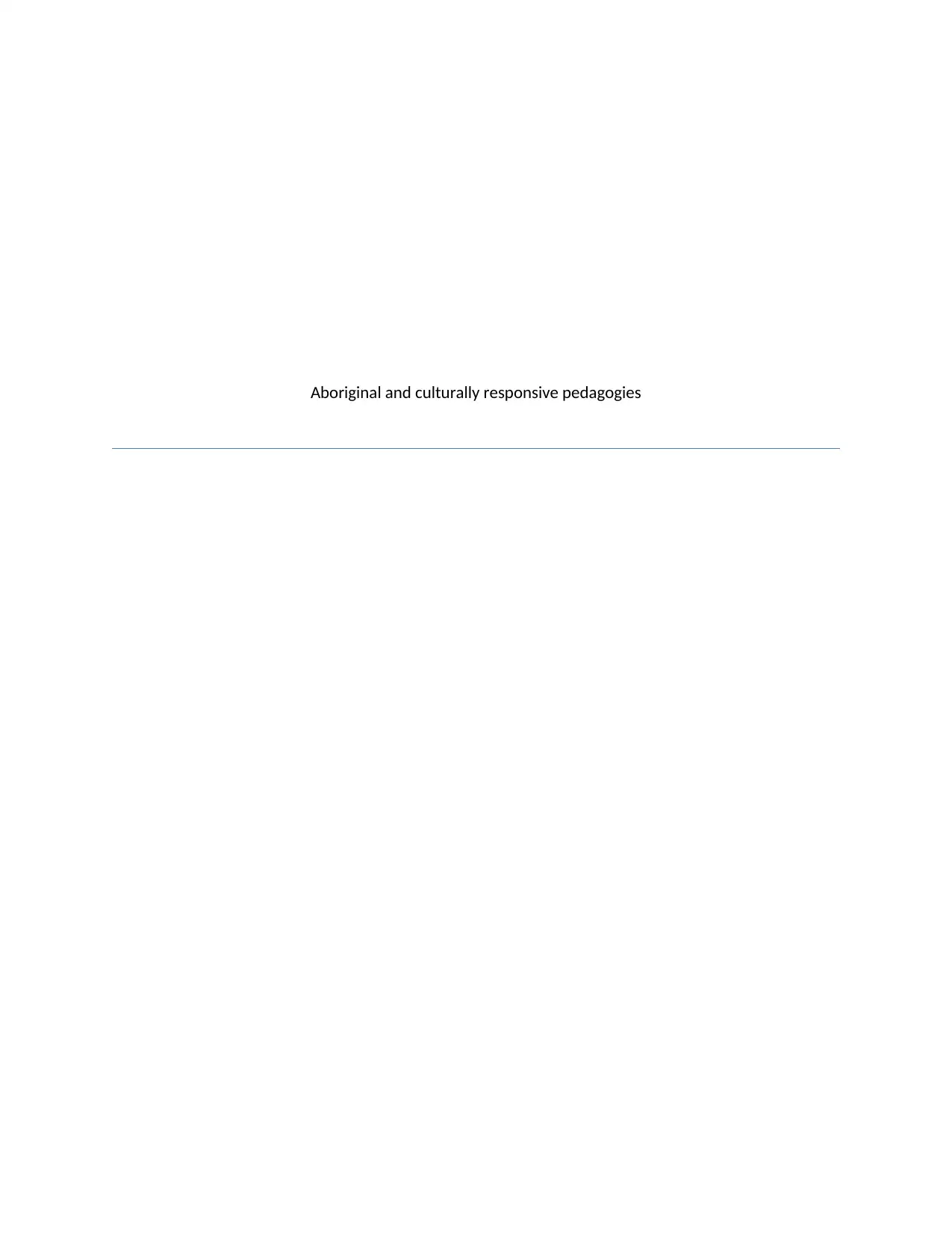
Aboriginal and culturally responsive pedagogies
Paraphrase This Document
Need a fresh take? Get an instant paraphrase of this document with our AI Paraphraser
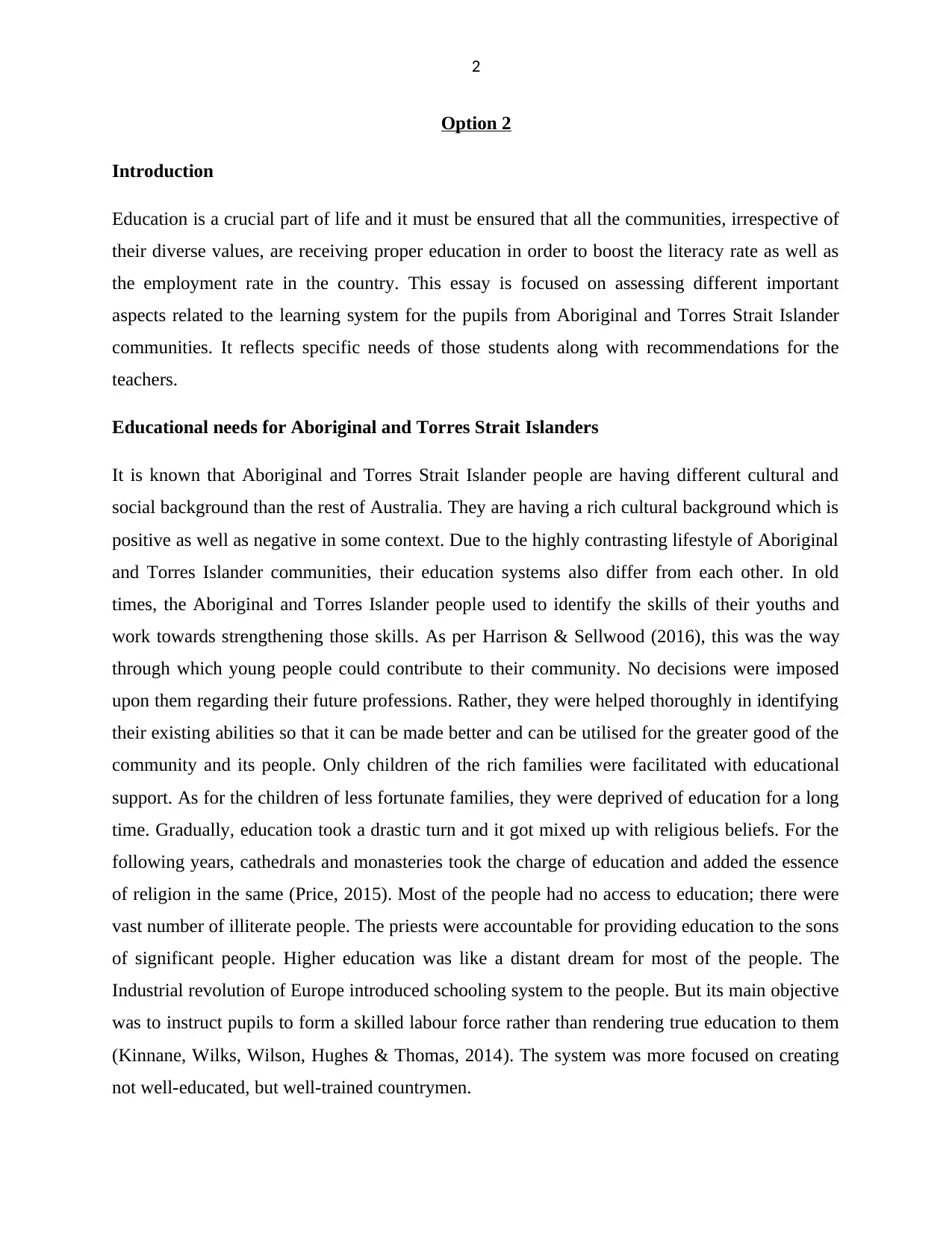
2
Option 2
Introduction
Education is a crucial part of life and it must be ensured that all the communities, irrespective of
their diverse values, are receiving proper education in order to boost the literacy rate as well as
the employment rate in the country. This essay is focused on assessing different important
aspects related to the learning system for the pupils from Aboriginal and Torres Strait Islander
communities. It reflects specific needs of those students along with recommendations for the
teachers.
Educational needs for Aboriginal and Torres Strait Islanders
It is known that Aboriginal and Torres Strait Islander people are having different cultural and
social background than the rest of Australia. They are having a rich cultural background which is
positive as well as negative in some context. Due to the highly contrasting lifestyle of Aboriginal
and Torres Islander communities, their education systems also differ from each other. In old
times, the Aboriginal and Torres Islander people used to identify the skills of their youths and
work towards strengthening those skills. As per Harrison & Sellwood (2016), this was the way
through which young people could contribute to their community. No decisions were imposed
upon them regarding their future professions. Rather, they were helped thoroughly in identifying
their existing abilities so that it can be made better and can be utilised for the greater good of the
community and its people. Only children of the rich families were facilitated with educational
support. As for the children of less fortunate families, they were deprived of education for a long
time. Gradually, education took a drastic turn and it got mixed up with religious beliefs. For the
following years, cathedrals and monasteries took the charge of education and added the essence
of religion in the same (Price, 2015). Most of the people had no access to education; there were
vast number of illiterate people. The priests were accountable for providing education to the sons
of significant people. Higher education was like a distant dream for most of the people. The
Industrial revolution of Europe introduced schooling system to the people. But its main objective
was to instruct pupils to form a skilled labour force rather than rendering true education to them
(Kinnane, Wilks, Wilson, Hughes & Thomas, 2014). The system was more focused on creating
not well-educated, but well-trained countrymen.
Option 2
Introduction
Education is a crucial part of life and it must be ensured that all the communities, irrespective of
their diverse values, are receiving proper education in order to boost the literacy rate as well as
the employment rate in the country. This essay is focused on assessing different important
aspects related to the learning system for the pupils from Aboriginal and Torres Strait Islander
communities. It reflects specific needs of those students along with recommendations for the
teachers.
Educational needs for Aboriginal and Torres Strait Islanders
It is known that Aboriginal and Torres Strait Islander people are having different cultural and
social background than the rest of Australia. They are having a rich cultural background which is
positive as well as negative in some context. Due to the highly contrasting lifestyle of Aboriginal
and Torres Islander communities, their education systems also differ from each other. In old
times, the Aboriginal and Torres Islander people used to identify the skills of their youths and
work towards strengthening those skills. As per Harrison & Sellwood (2016), this was the way
through which young people could contribute to their community. No decisions were imposed
upon them regarding their future professions. Rather, they were helped thoroughly in identifying
their existing abilities so that it can be made better and can be utilised for the greater good of the
community and its people. Only children of the rich families were facilitated with educational
support. As for the children of less fortunate families, they were deprived of education for a long
time. Gradually, education took a drastic turn and it got mixed up with religious beliefs. For the
following years, cathedrals and monasteries took the charge of education and added the essence
of religion in the same (Price, 2015). Most of the people had no access to education; there were
vast number of illiterate people. The priests were accountable for providing education to the sons
of significant people. Higher education was like a distant dream for most of the people. The
Industrial revolution of Europe introduced schooling system to the people. But its main objective
was to instruct pupils to form a skilled labour force rather than rendering true education to them
(Kinnane, Wilks, Wilson, Hughes & Thomas, 2014). The system was more focused on creating
not well-educated, but well-trained countrymen.
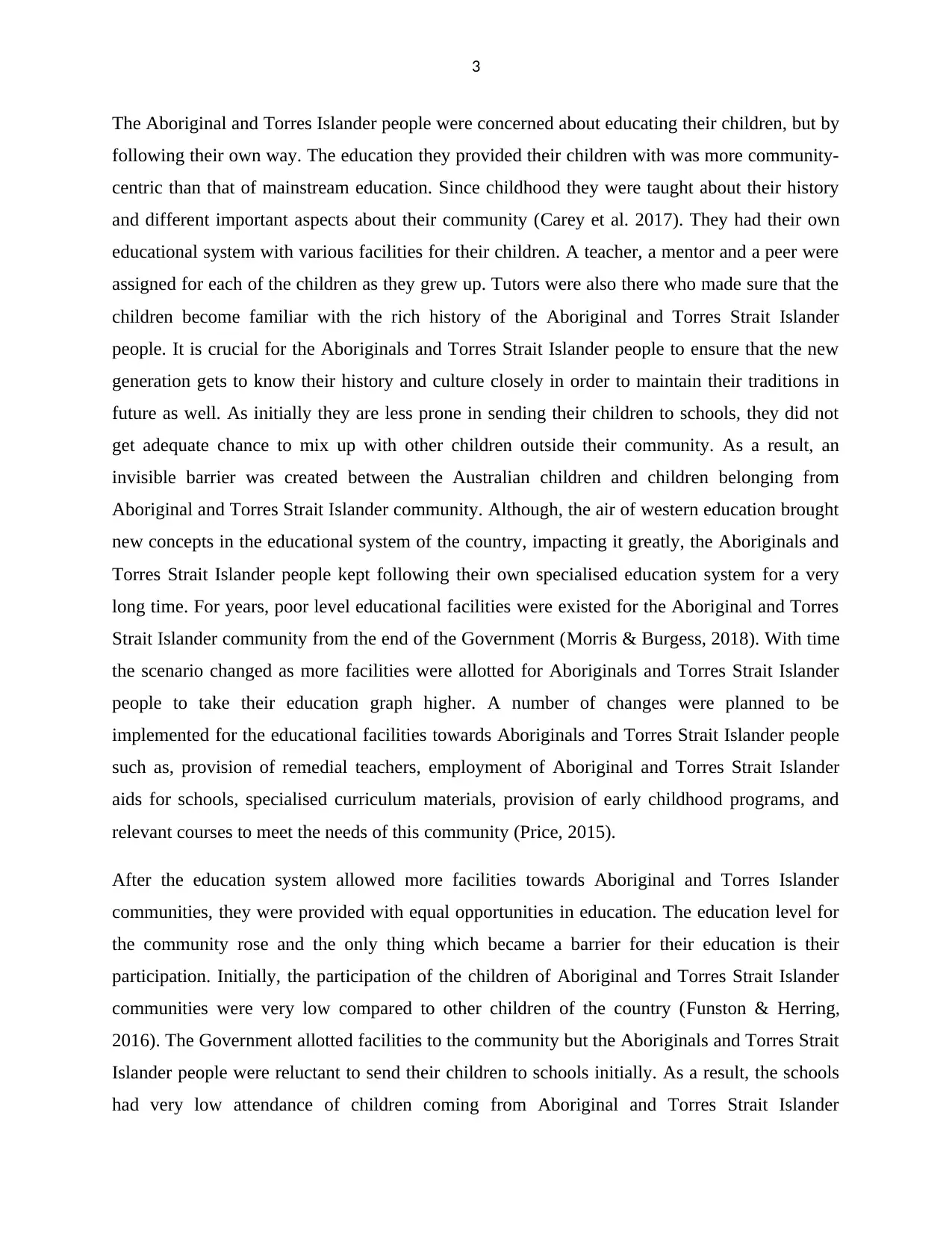
3
The Aboriginal and Torres Islander people were concerned about educating their children, but by
following their own way. The education they provided their children with was more community-
centric than that of mainstream education. Since childhood they were taught about their history
and different important aspects about their community (Carey et al. 2017). They had their own
educational system with various facilities for their children. A teacher, a mentor and a peer were
assigned for each of the children as they grew up. Tutors were also there who made sure that the
children become familiar with the rich history of the Aboriginal and Torres Strait Islander
people. It is crucial for the Aboriginals and Torres Strait Islander people to ensure that the new
generation gets to know their history and culture closely in order to maintain their traditions in
future as well. As initially they are less prone in sending their children to schools, they did not
get adequate chance to mix up with other children outside their community. As a result, an
invisible barrier was created between the Australian children and children belonging from
Aboriginal and Torres Strait Islander community. Although, the air of western education brought
new concepts in the educational system of the country, impacting it greatly, the Aboriginals and
Torres Strait Islander people kept following their own specialised education system for a very
long time. For years, poor level educational facilities were existed for the Aboriginal and Torres
Strait Islander community from the end of the Government (Morris & Burgess, 2018). With time
the scenario changed as more facilities were allotted for Aboriginals and Torres Strait Islander
people to take their education graph higher. A number of changes were planned to be
implemented for the educational facilities towards Aboriginals and Torres Strait Islander people
such as, provision of remedial teachers, employment of Aboriginal and Torres Strait Islander
aids for schools, specialised curriculum materials, provision of early childhood programs, and
relevant courses to meet the needs of this community (Price, 2015).
After the education system allowed more facilities towards Aboriginal and Torres Islander
communities, they were provided with equal opportunities in education. The education level for
the community rose and the only thing which became a barrier for their education is their
participation. Initially, the participation of the children of Aboriginal and Torres Strait Islander
communities were very low compared to other children of the country (Funston & Herring,
2016). The Government allotted facilities to the community but the Aboriginals and Torres Strait
Islander people were reluctant to send their children to schools initially. As a result, the schools
had very low attendance of children coming from Aboriginal and Torres Strait Islander
The Aboriginal and Torres Islander people were concerned about educating their children, but by
following their own way. The education they provided their children with was more community-
centric than that of mainstream education. Since childhood they were taught about their history
and different important aspects about their community (Carey et al. 2017). They had their own
educational system with various facilities for their children. A teacher, a mentor and a peer were
assigned for each of the children as they grew up. Tutors were also there who made sure that the
children become familiar with the rich history of the Aboriginal and Torres Strait Islander
people. It is crucial for the Aboriginals and Torres Strait Islander people to ensure that the new
generation gets to know their history and culture closely in order to maintain their traditions in
future as well. As initially they are less prone in sending their children to schools, they did not
get adequate chance to mix up with other children outside their community. As a result, an
invisible barrier was created between the Australian children and children belonging from
Aboriginal and Torres Strait Islander community. Although, the air of western education brought
new concepts in the educational system of the country, impacting it greatly, the Aboriginals and
Torres Strait Islander people kept following their own specialised education system for a very
long time. For years, poor level educational facilities were existed for the Aboriginal and Torres
Strait Islander community from the end of the Government (Morris & Burgess, 2018). With time
the scenario changed as more facilities were allotted for Aboriginals and Torres Strait Islander
people to take their education graph higher. A number of changes were planned to be
implemented for the educational facilities towards Aboriginals and Torres Strait Islander people
such as, provision of remedial teachers, employment of Aboriginal and Torres Strait Islander
aids for schools, specialised curriculum materials, provision of early childhood programs, and
relevant courses to meet the needs of this community (Price, 2015).
After the education system allowed more facilities towards Aboriginal and Torres Islander
communities, they were provided with equal opportunities in education. The education level for
the community rose and the only thing which became a barrier for their education is their
participation. Initially, the participation of the children of Aboriginal and Torres Strait Islander
communities were very low compared to other children of the country (Funston & Herring,
2016). The Government allotted facilities to the community but the Aboriginals and Torres Strait
Islander people were reluctant to send their children to schools initially. As a result, the schools
had very low attendance of children coming from Aboriginal and Torres Strait Islander
⊘ This is a preview!⊘
Do you want full access?
Subscribe today to unlock all pages.

Trusted by 1+ million students worldwide
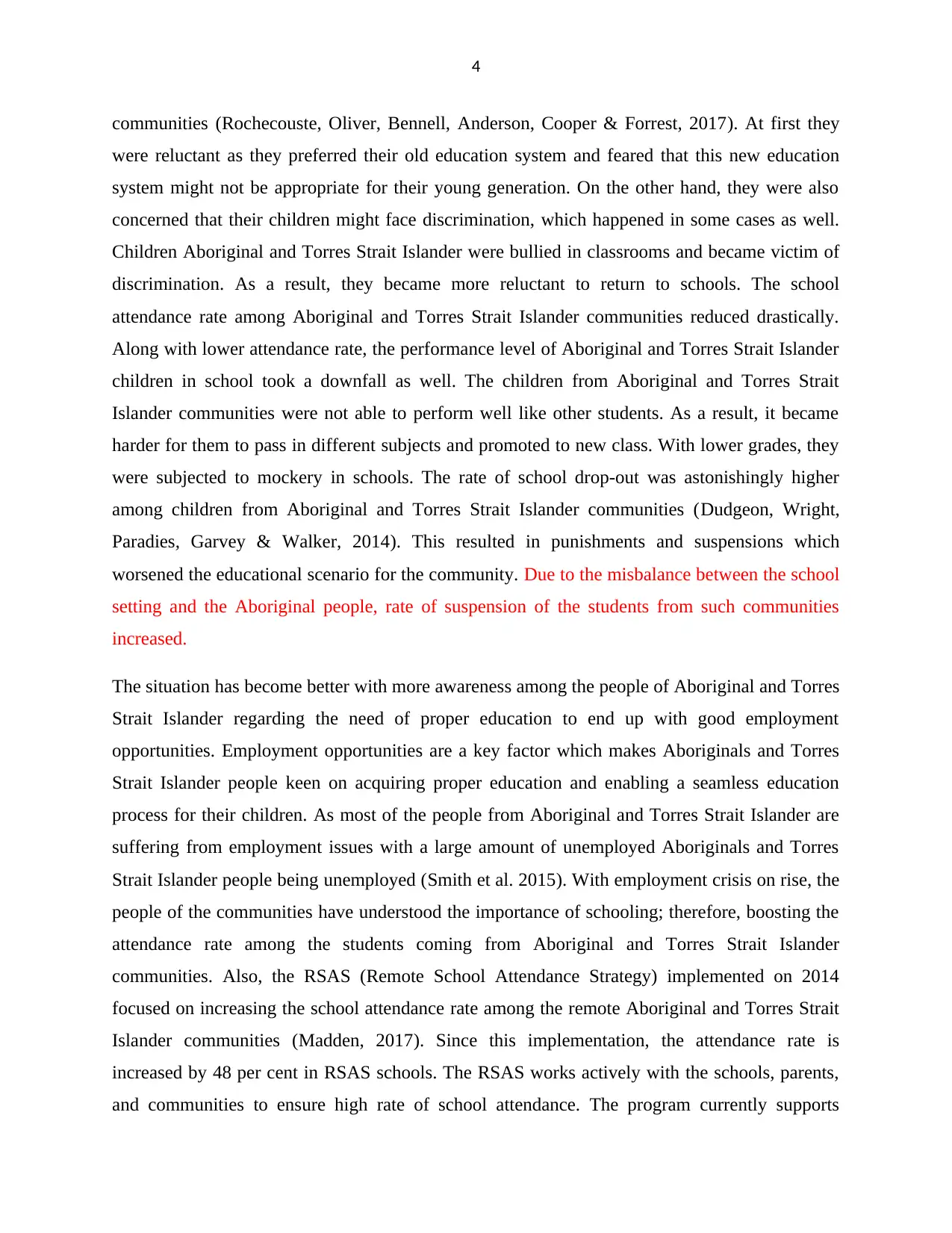
4
communities (Rochecouste, Oliver, Bennell, Anderson, Cooper & Forrest, 2017). At first they
were reluctant as they preferred their old education system and feared that this new education
system might not be appropriate for their young generation. On the other hand, they were also
concerned that their children might face discrimination, which happened in some cases as well.
Children Aboriginal and Torres Strait Islander were bullied in classrooms and became victim of
discrimination. As a result, they became more reluctant to return to schools. The school
attendance rate among Aboriginal and Torres Strait Islander communities reduced drastically.
Along with lower attendance rate, the performance level of Aboriginal and Torres Strait Islander
children in school took a downfall as well. The children from Aboriginal and Torres Strait
Islander communities were not able to perform well like other students. As a result, it became
harder for them to pass in different subjects and promoted to new class. With lower grades, they
were subjected to mockery in schools. The rate of school drop-out was astonishingly higher
among children from Aboriginal and Torres Strait Islander communities (Dudgeon, Wright,
Paradies, Garvey & Walker, 2014). This resulted in punishments and suspensions which
worsened the educational scenario for the community. Due to the misbalance between the school
setting and the Aboriginal people, rate of suspension of the students from such communities
increased.
The situation has become better with more awareness among the people of Aboriginal and Torres
Strait Islander regarding the need of proper education to end up with good employment
opportunities. Employment opportunities are a key factor which makes Aboriginals and Torres
Strait Islander people keen on acquiring proper education and enabling a seamless education
process for their children. As most of the people from Aboriginal and Torres Strait Islander are
suffering from employment issues with a large amount of unemployed Aboriginals and Torres
Strait Islander people being unemployed (Smith et al. 2015). With employment crisis on rise, the
people of the communities have understood the importance of schooling; therefore, boosting the
attendance rate among the students coming from Aboriginal and Torres Strait Islander
communities. Also, the RSAS (Remote School Attendance Strategy) implemented on 2014
focused on increasing the school attendance rate among the remote Aboriginal and Torres Strait
Islander communities (Madden, 2017). Since this implementation, the attendance rate is
increased by 48 per cent in RSAS schools. The RSAS works actively with the schools, parents,
and communities to ensure high rate of school attendance. The program currently supports
communities (Rochecouste, Oliver, Bennell, Anderson, Cooper & Forrest, 2017). At first they
were reluctant as they preferred their old education system and feared that this new education
system might not be appropriate for their young generation. On the other hand, they were also
concerned that their children might face discrimination, which happened in some cases as well.
Children Aboriginal and Torres Strait Islander were bullied in classrooms and became victim of
discrimination. As a result, they became more reluctant to return to schools. The school
attendance rate among Aboriginal and Torres Strait Islander communities reduced drastically.
Along with lower attendance rate, the performance level of Aboriginal and Torres Strait Islander
children in school took a downfall as well. The children from Aboriginal and Torres Strait
Islander communities were not able to perform well like other students. As a result, it became
harder for them to pass in different subjects and promoted to new class. With lower grades, they
were subjected to mockery in schools. The rate of school drop-out was astonishingly higher
among children from Aboriginal and Torres Strait Islander communities (Dudgeon, Wright,
Paradies, Garvey & Walker, 2014). This resulted in punishments and suspensions which
worsened the educational scenario for the community. Due to the misbalance between the school
setting and the Aboriginal people, rate of suspension of the students from such communities
increased.
The situation has become better with more awareness among the people of Aboriginal and Torres
Strait Islander regarding the need of proper education to end up with good employment
opportunities. Employment opportunities are a key factor which makes Aboriginals and Torres
Strait Islander people keen on acquiring proper education and enabling a seamless education
process for their children. As most of the people from Aboriginal and Torres Strait Islander are
suffering from employment issues with a large amount of unemployed Aboriginals and Torres
Strait Islander people being unemployed (Smith et al. 2015). With employment crisis on rise, the
people of the communities have understood the importance of schooling; therefore, boosting the
attendance rate among the students coming from Aboriginal and Torres Strait Islander
communities. Also, the RSAS (Remote School Attendance Strategy) implemented on 2014
focused on increasing the school attendance rate among the remote Aboriginal and Torres Strait
Islander communities (Madden, 2017). Since this implementation, the attendance rate is
increased by 48 per cent in RSAS schools. The RSAS works actively with the schools, parents,
and communities to ensure high rate of school attendance. The program currently supports
Paraphrase This Document
Need a fresh take? Get an instant paraphrase of this document with our AI Paraphraser
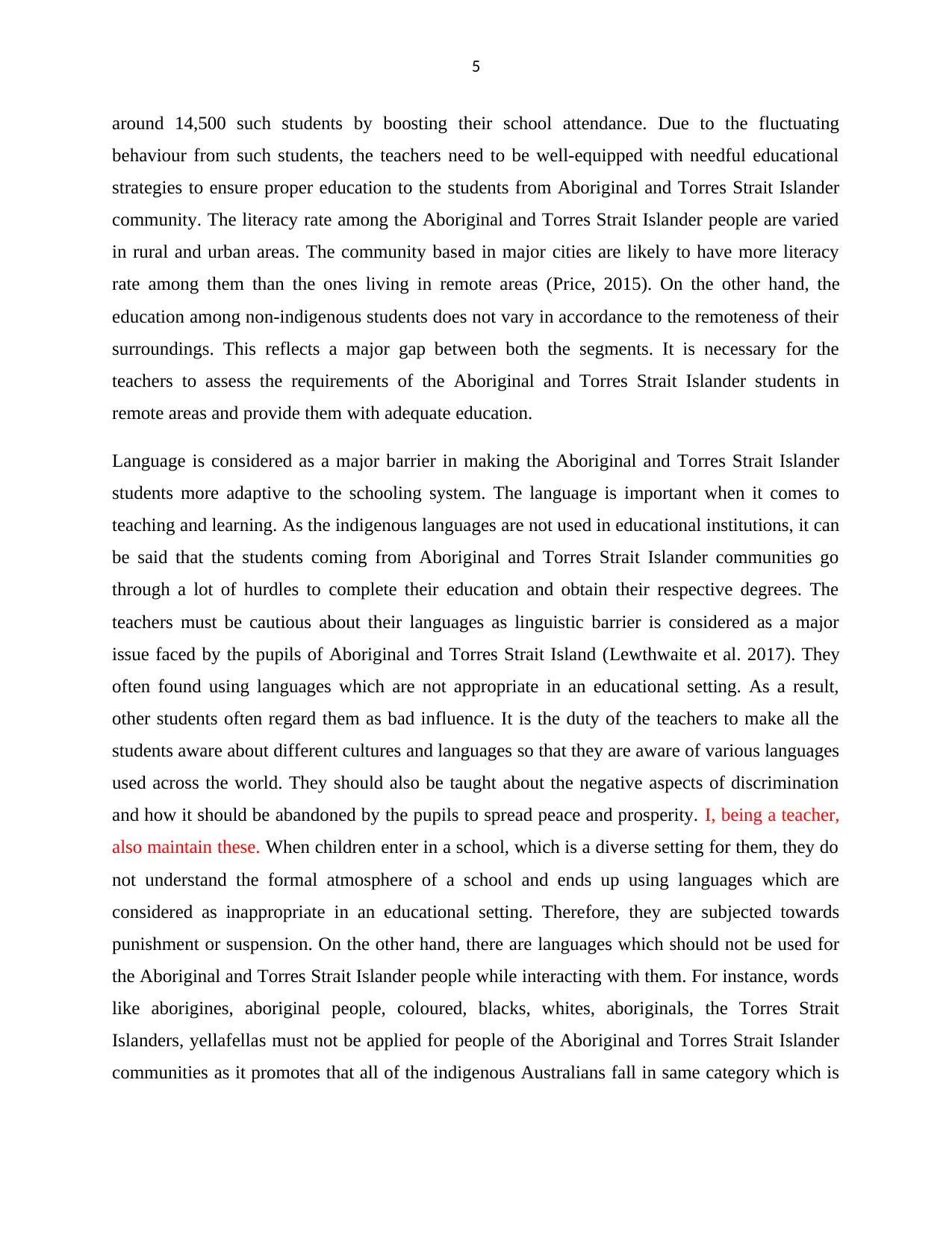
5
around 14,500 such students by boosting their school attendance. Due to the fluctuating
behaviour from such students, the teachers need to be well-equipped with needful educational
strategies to ensure proper education to the students from Aboriginal and Torres Strait Islander
community. The literacy rate among the Aboriginal and Torres Strait Islander people are varied
in rural and urban areas. The community based in major cities are likely to have more literacy
rate among them than the ones living in remote areas (Price, 2015). On the other hand, the
education among non-indigenous students does not vary in accordance to the remoteness of their
surroundings. This reflects a major gap between both the segments. It is necessary for the
teachers to assess the requirements of the Aboriginal and Torres Strait Islander students in
remote areas and provide them with adequate education.
Language is considered as a major barrier in making the Aboriginal and Torres Strait Islander
students more adaptive to the schooling system. The language is important when it comes to
teaching and learning. As the indigenous languages are not used in educational institutions, it can
be said that the students coming from Aboriginal and Torres Strait Islander communities go
through a lot of hurdles to complete their education and obtain their respective degrees. The
teachers must be cautious about their languages as linguistic barrier is considered as a major
issue faced by the pupils of Aboriginal and Torres Strait Island (Lewthwaite et al. 2017). They
often found using languages which are not appropriate in an educational setting. As a result,
other students often regard them as bad influence. It is the duty of the teachers to make all the
students aware about different cultures and languages so that they are aware of various languages
used across the world. They should also be taught about the negative aspects of discrimination
and how it should be abandoned by the pupils to spread peace and prosperity. I, being a teacher,
also maintain these. When children enter in a school, which is a diverse setting for them, they do
not understand the formal atmosphere of a school and ends up using languages which are
considered as inappropriate in an educational setting. Therefore, they are subjected towards
punishment or suspension. On the other hand, there are languages which should not be used for
the Aboriginal and Torres Strait Islander people while interacting with them. For instance, words
like aborigines, aboriginal people, coloured, blacks, whites, aboriginals, the Torres Strait
Islanders, yellafellas must not be applied for people of the Aboriginal and Torres Strait Islander
communities as it promotes that all of the indigenous Australians fall in same category which is
around 14,500 such students by boosting their school attendance. Due to the fluctuating
behaviour from such students, the teachers need to be well-equipped with needful educational
strategies to ensure proper education to the students from Aboriginal and Torres Strait Islander
community. The literacy rate among the Aboriginal and Torres Strait Islander people are varied
in rural and urban areas. The community based in major cities are likely to have more literacy
rate among them than the ones living in remote areas (Price, 2015). On the other hand, the
education among non-indigenous students does not vary in accordance to the remoteness of their
surroundings. This reflects a major gap between both the segments. It is necessary for the
teachers to assess the requirements of the Aboriginal and Torres Strait Islander students in
remote areas and provide them with adequate education.
Language is considered as a major barrier in making the Aboriginal and Torres Strait Islander
students more adaptive to the schooling system. The language is important when it comes to
teaching and learning. As the indigenous languages are not used in educational institutions, it can
be said that the students coming from Aboriginal and Torres Strait Islander communities go
through a lot of hurdles to complete their education and obtain their respective degrees. The
teachers must be cautious about their languages as linguistic barrier is considered as a major
issue faced by the pupils of Aboriginal and Torres Strait Island (Lewthwaite et al. 2017). They
often found using languages which are not appropriate in an educational setting. As a result,
other students often regard them as bad influence. It is the duty of the teachers to make all the
students aware about different cultures and languages so that they are aware of various languages
used across the world. They should also be taught about the negative aspects of discrimination
and how it should be abandoned by the pupils to spread peace and prosperity. I, being a teacher,
also maintain these. When children enter in a school, which is a diverse setting for them, they do
not understand the formal atmosphere of a school and ends up using languages which are
considered as inappropriate in an educational setting. Therefore, they are subjected towards
punishment or suspension. On the other hand, there are languages which should not be used for
the Aboriginal and Torres Strait Islander people while interacting with them. For instance, words
like aborigines, aboriginal people, coloured, blacks, whites, aboriginals, the Torres Strait
Islanders, yellafellas must not be applied for people of the Aboriginal and Torres Strait Islander
communities as it promotes that all of the indigenous Australians fall in same category which is
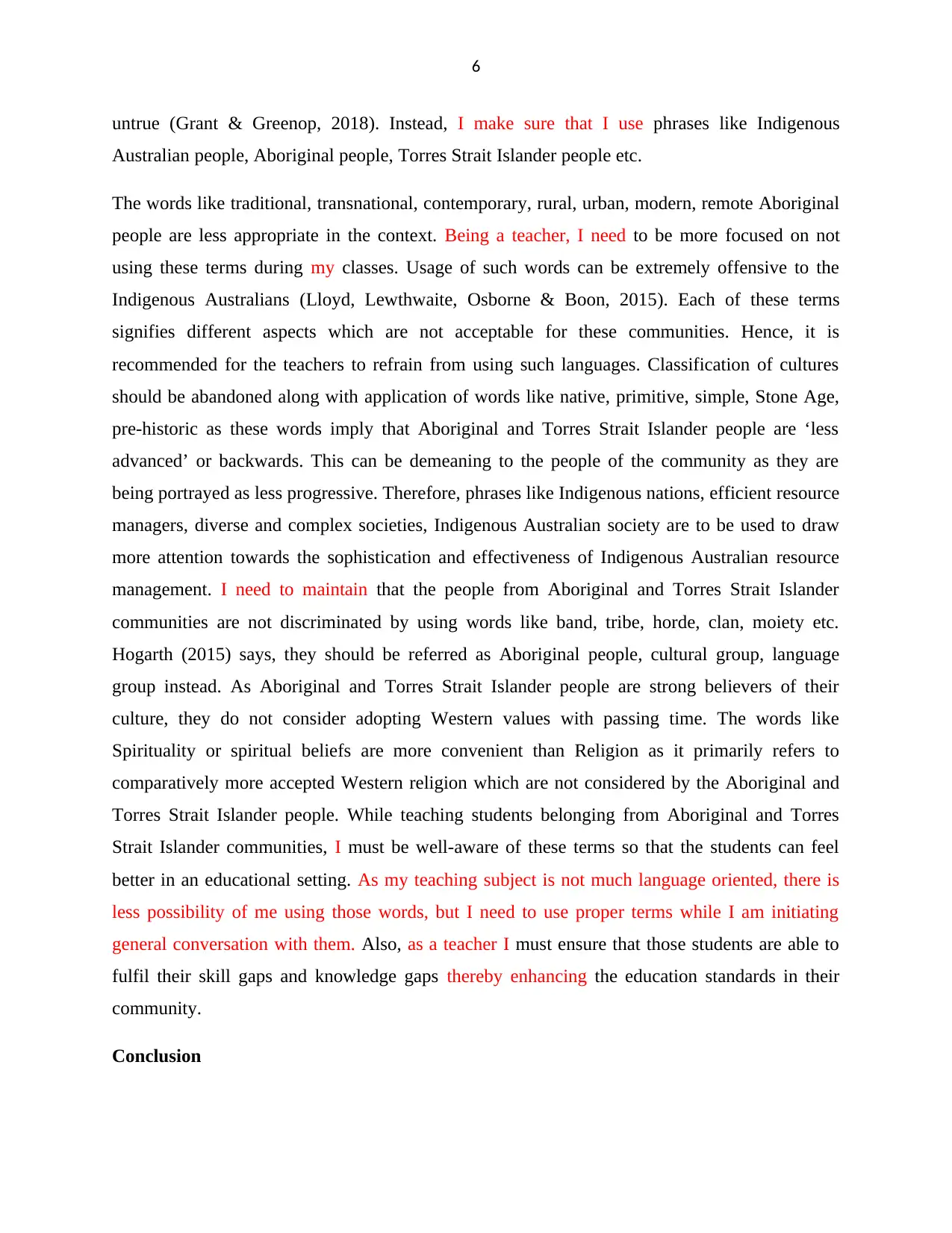
6
untrue (Grant & Greenop, 2018). Instead, I make sure that I use phrases like Indigenous
Australian people, Aboriginal people, Torres Strait Islander people etc.
The words like traditional, transnational, contemporary, rural, urban, modern, remote Aboriginal
people are less appropriate in the context. Being a teacher, I need to be more focused on not
using these terms during my classes. Usage of such words can be extremely offensive to the
Indigenous Australians (Lloyd, Lewthwaite, Osborne & Boon, 2015). Each of these terms
signifies different aspects which are not acceptable for these communities. Hence, it is
recommended for the teachers to refrain from using such languages. Classification of cultures
should be abandoned along with application of words like native, primitive, simple, Stone Age,
pre-historic as these words imply that Aboriginal and Torres Strait Islander people are ‘less
advanced’ or backwards. This can be demeaning to the people of the community as they are
being portrayed as less progressive. Therefore, phrases like Indigenous nations, efficient resource
managers, diverse and complex societies, Indigenous Australian society are to be used to draw
more attention towards the sophistication and effectiveness of Indigenous Australian resource
management. I need to maintain that the people from Aboriginal and Torres Strait Islander
communities are not discriminated by using words like band, tribe, horde, clan, moiety etc.
Hogarth (2015) says, they should be referred as Aboriginal people, cultural group, language
group instead. As Aboriginal and Torres Strait Islander people are strong believers of their
culture, they do not consider adopting Western values with passing time. The words like
Spirituality or spiritual beliefs are more convenient than Religion as it primarily refers to
comparatively more accepted Western religion which are not considered by the Aboriginal and
Torres Strait Islander people. While teaching students belonging from Aboriginal and Torres
Strait Islander communities, I must be well-aware of these terms so that the students can feel
better in an educational setting. As my teaching subject is not much language oriented, there is
less possibility of me using those words, but I need to use proper terms while I am initiating
general conversation with them. Also, as a teacher I must ensure that those students are able to
fulfil their skill gaps and knowledge gaps thereby enhancing the education standards in their
community.
Conclusion
untrue (Grant & Greenop, 2018). Instead, I make sure that I use phrases like Indigenous
Australian people, Aboriginal people, Torres Strait Islander people etc.
The words like traditional, transnational, contemporary, rural, urban, modern, remote Aboriginal
people are less appropriate in the context. Being a teacher, I need to be more focused on not
using these terms during my classes. Usage of such words can be extremely offensive to the
Indigenous Australians (Lloyd, Lewthwaite, Osborne & Boon, 2015). Each of these terms
signifies different aspects which are not acceptable for these communities. Hence, it is
recommended for the teachers to refrain from using such languages. Classification of cultures
should be abandoned along with application of words like native, primitive, simple, Stone Age,
pre-historic as these words imply that Aboriginal and Torres Strait Islander people are ‘less
advanced’ or backwards. This can be demeaning to the people of the community as they are
being portrayed as less progressive. Therefore, phrases like Indigenous nations, efficient resource
managers, diverse and complex societies, Indigenous Australian society are to be used to draw
more attention towards the sophistication and effectiveness of Indigenous Australian resource
management. I need to maintain that the people from Aboriginal and Torres Strait Islander
communities are not discriminated by using words like band, tribe, horde, clan, moiety etc.
Hogarth (2015) says, they should be referred as Aboriginal people, cultural group, language
group instead. As Aboriginal and Torres Strait Islander people are strong believers of their
culture, they do not consider adopting Western values with passing time. The words like
Spirituality or spiritual beliefs are more convenient than Religion as it primarily refers to
comparatively more accepted Western religion which are not considered by the Aboriginal and
Torres Strait Islander people. While teaching students belonging from Aboriginal and Torres
Strait Islander communities, I must be well-aware of these terms so that the students can feel
better in an educational setting. As my teaching subject is not much language oriented, there is
less possibility of me using those words, but I need to use proper terms while I am initiating
general conversation with them. Also, as a teacher I must ensure that those students are able to
fulfil their skill gaps and knowledge gaps thereby enhancing the education standards in their
community.
Conclusion
⊘ This is a preview!⊘
Do you want full access?
Subscribe today to unlock all pages.

Trusted by 1+ million students worldwide
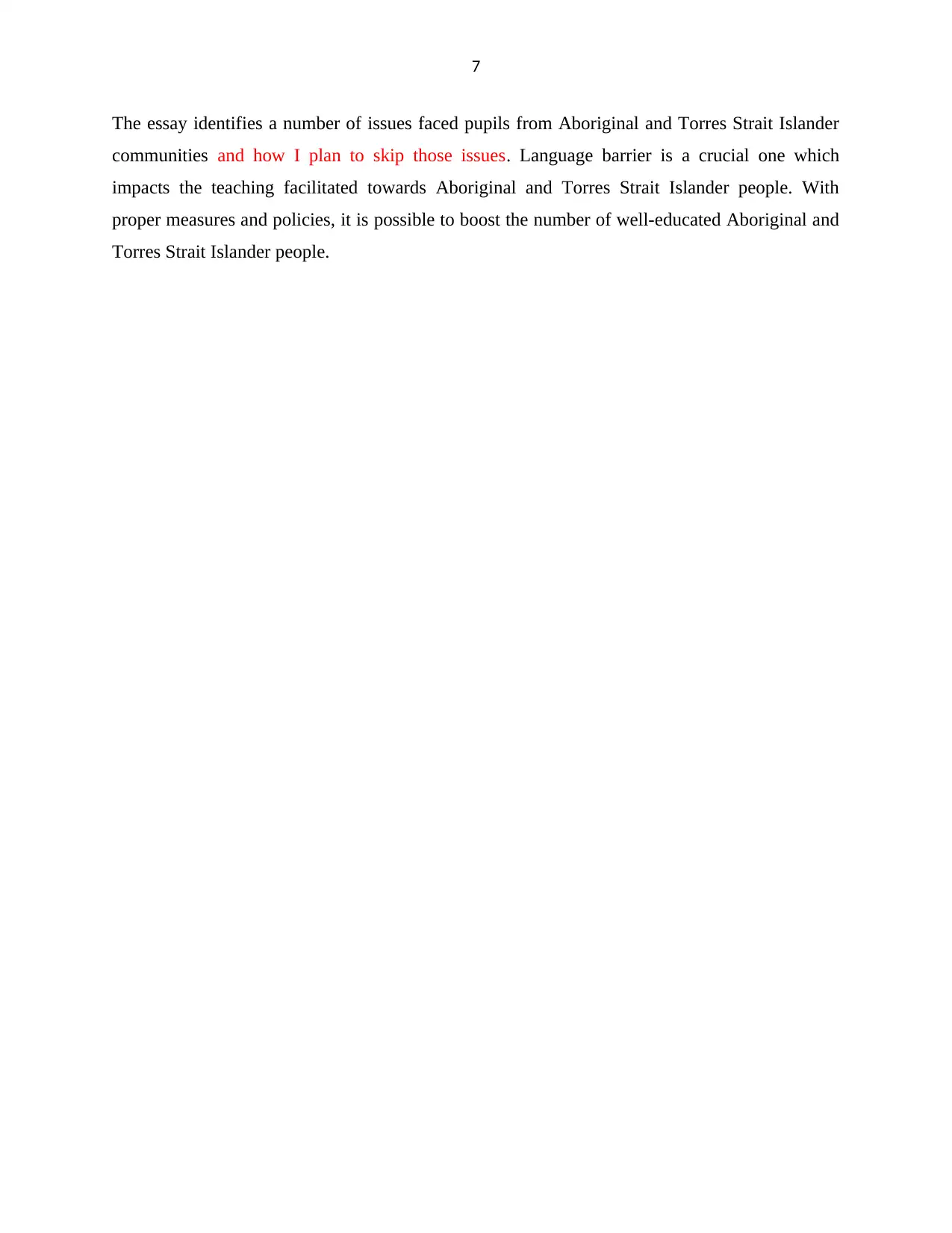
7
The essay identifies a number of issues faced pupils from Aboriginal and Torres Strait Islander
communities and how I plan to skip those issues. Language barrier is a crucial one which
impacts the teaching facilitated towards Aboriginal and Torres Strait Islander people. With
proper measures and policies, it is possible to boost the number of well-educated Aboriginal and
Torres Strait Islander people.
The essay identifies a number of issues faced pupils from Aboriginal and Torres Strait Islander
communities and how I plan to skip those issues. Language barrier is a crucial one which
impacts the teaching facilitated towards Aboriginal and Torres Strait Islander people. With
proper measures and policies, it is possible to boost the number of well-educated Aboriginal and
Torres Strait Islander people.
Paraphrase This Document
Need a fresh take? Get an instant paraphrase of this document with our AI Paraphraser
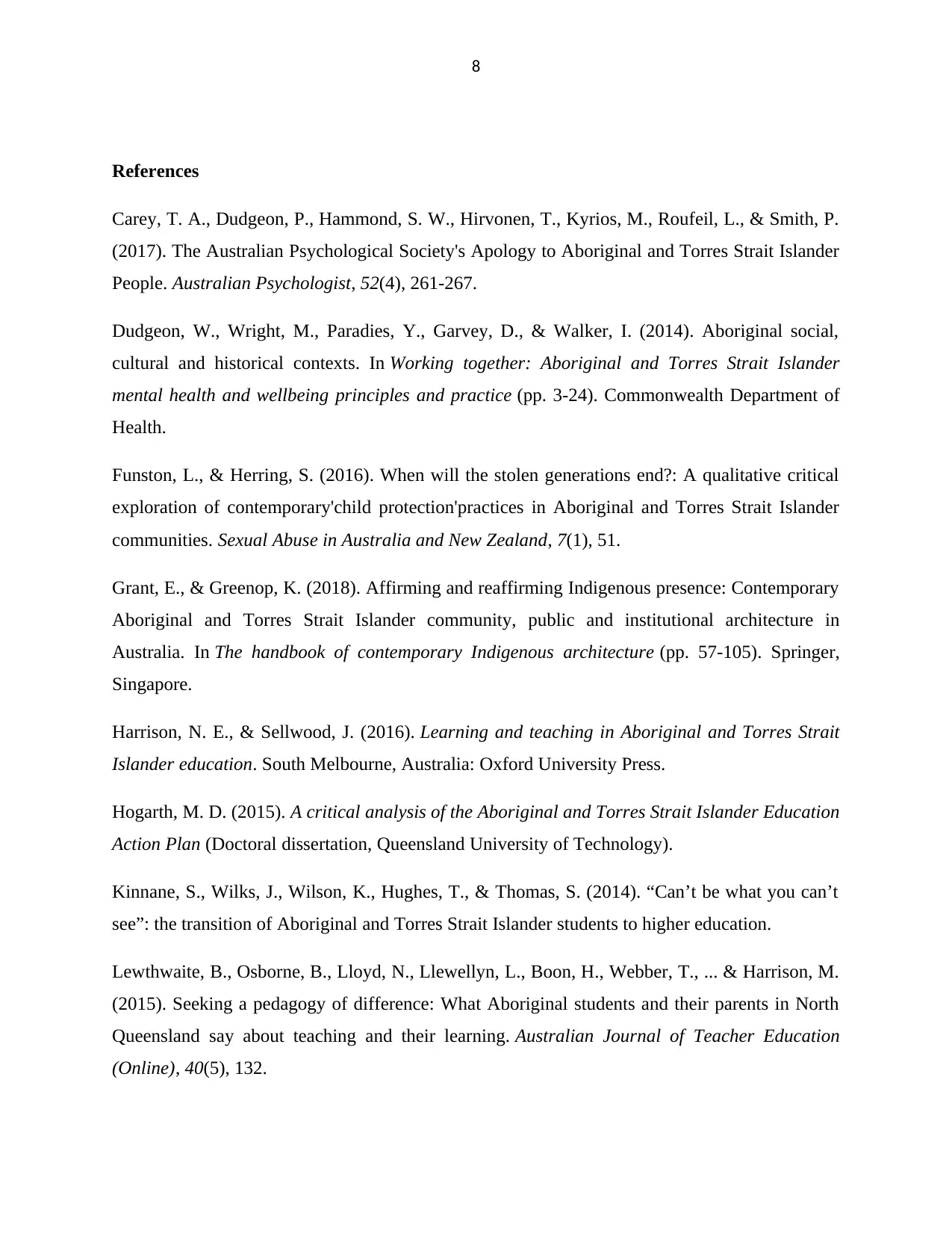
8
References
Carey, T. A., Dudgeon, P., Hammond, S. W., Hirvonen, T., Kyrios, M., Roufeil, L., & Smith, P.
(2017). The Australian Psychological Society's Apology to Aboriginal and Torres Strait Islander
People. Australian Psychologist, 52(4), 261-267.
Dudgeon, W., Wright, M., Paradies, Y., Garvey, D., & Walker, I. (2014). Aboriginal social,
cultural and historical contexts. In Working together: Aboriginal and Torres Strait Islander
mental health and wellbeing principles and practice (pp. 3-24). Commonwealth Department of
Health.
Funston, L., & Herring, S. (2016). When will the stolen generations end?: A qualitative critical
exploration of contemporary'child protection'practices in Aboriginal and Torres Strait Islander
communities. Sexual Abuse in Australia and New Zealand, 7(1), 51.
Grant, E., & Greenop, K. (2018). Affirming and reaffirming Indigenous presence: Contemporary
Aboriginal and Torres Strait Islander community, public and institutional architecture in
Australia. In The handbook of contemporary Indigenous architecture (pp. 57-105). Springer,
Singapore.
Harrison, N. E., & Sellwood, J. (2016). Learning and teaching in Aboriginal and Torres Strait
Islander education. South Melbourne, Australia: Oxford University Press.
Hogarth, M. D. (2015). A critical analysis of the Aboriginal and Torres Strait Islander Education
Action Plan (Doctoral dissertation, Queensland University of Technology).
Kinnane, S., Wilks, J., Wilson, K., Hughes, T., & Thomas, S. (2014). “Can’t be what you can’t
see”: the transition of Aboriginal and Torres Strait Islander students to higher education.
Lewthwaite, B., Osborne, B., Lloyd, N., Llewellyn, L., Boon, H., Webber, T., ... & Harrison, M.
(2015). Seeking a pedagogy of difference: What Aboriginal students and their parents in North
Queensland say about teaching and their learning. Australian Journal of Teacher Education
(Online), 40(5), 132.
References
Carey, T. A., Dudgeon, P., Hammond, S. W., Hirvonen, T., Kyrios, M., Roufeil, L., & Smith, P.
(2017). The Australian Psychological Society's Apology to Aboriginal and Torres Strait Islander
People. Australian Psychologist, 52(4), 261-267.
Dudgeon, W., Wright, M., Paradies, Y., Garvey, D., & Walker, I. (2014). Aboriginal social,
cultural and historical contexts. In Working together: Aboriginal and Torres Strait Islander
mental health and wellbeing principles and practice (pp. 3-24). Commonwealth Department of
Health.
Funston, L., & Herring, S. (2016). When will the stolen generations end?: A qualitative critical
exploration of contemporary'child protection'practices in Aboriginal and Torres Strait Islander
communities. Sexual Abuse in Australia and New Zealand, 7(1), 51.
Grant, E., & Greenop, K. (2018). Affirming and reaffirming Indigenous presence: Contemporary
Aboriginal and Torres Strait Islander community, public and institutional architecture in
Australia. In The handbook of contemporary Indigenous architecture (pp. 57-105). Springer,
Singapore.
Harrison, N. E., & Sellwood, J. (2016). Learning and teaching in Aboriginal and Torres Strait
Islander education. South Melbourne, Australia: Oxford University Press.
Hogarth, M. D. (2015). A critical analysis of the Aboriginal and Torres Strait Islander Education
Action Plan (Doctoral dissertation, Queensland University of Technology).
Kinnane, S., Wilks, J., Wilson, K., Hughes, T., & Thomas, S. (2014). “Can’t be what you can’t
see”: the transition of Aboriginal and Torres Strait Islander students to higher education.
Lewthwaite, B., Osborne, B., Lloyd, N., Llewellyn, L., Boon, H., Webber, T., ... & Harrison, M.
(2015). Seeking a pedagogy of difference: What Aboriginal students and their parents in North
Queensland say about teaching and their learning. Australian Journal of Teacher Education
(Online), 40(5), 132.
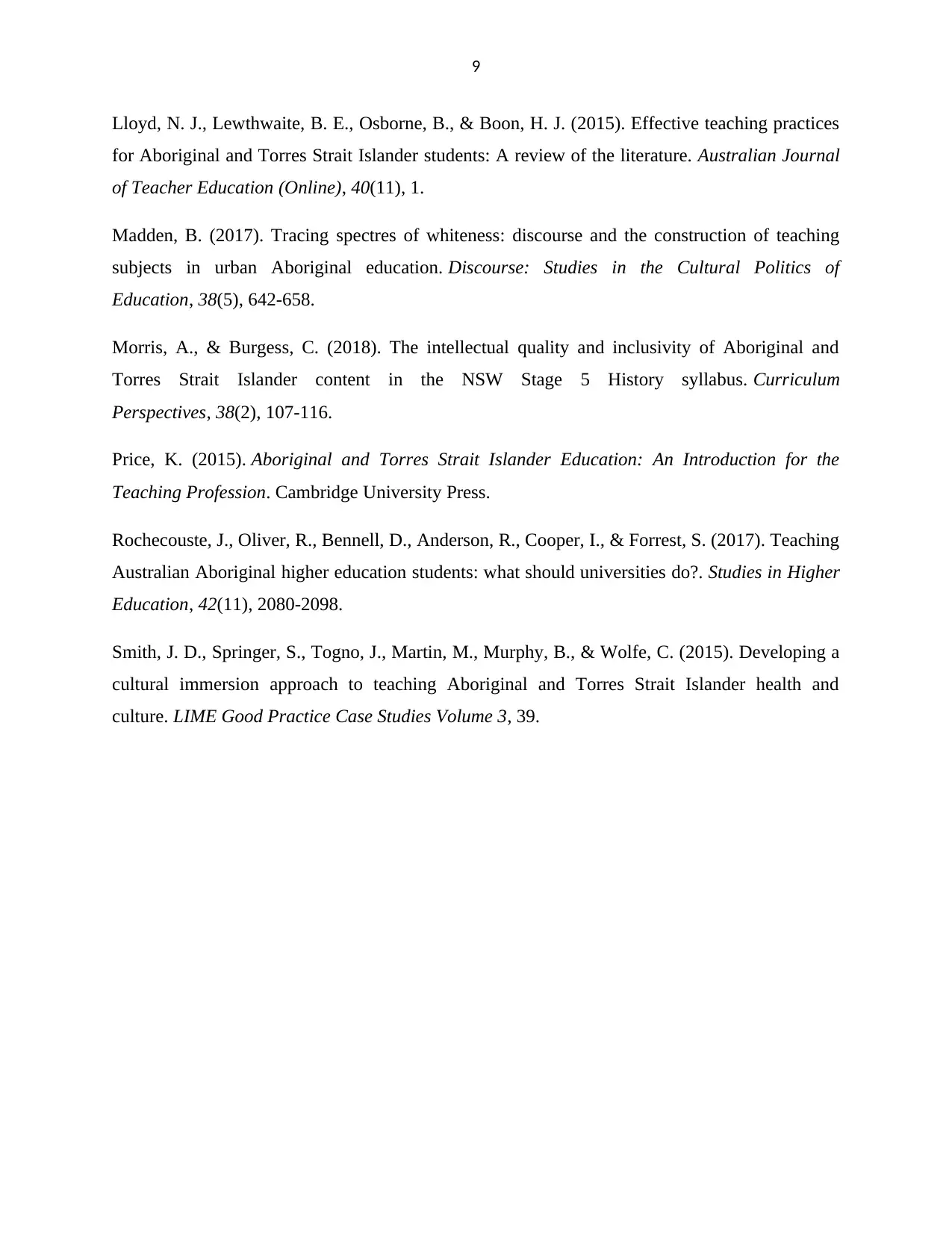
9
Lloyd, N. J., Lewthwaite, B. E., Osborne, B., & Boon, H. J. (2015). Effective teaching practices
for Aboriginal and Torres Strait Islander students: A review of the literature. Australian Journal
of Teacher Education (Online), 40(11), 1.
Madden, B. (2017). Tracing spectres of whiteness: discourse and the construction of teaching
subjects in urban Aboriginal education. Discourse: Studies in the Cultural Politics of
Education, 38(5), 642-658.
Morris, A., & Burgess, C. (2018). The intellectual quality and inclusivity of Aboriginal and
Torres Strait Islander content in the NSW Stage 5 History syllabus. Curriculum
Perspectives, 38(2), 107-116.
Price, K. (2015). Aboriginal and Torres Strait Islander Education: An Introduction for the
Teaching Profession. Cambridge University Press.
Rochecouste, J., Oliver, R., Bennell, D., Anderson, R., Cooper, I., & Forrest, S. (2017). Teaching
Australian Aboriginal higher education students: what should universities do?. Studies in Higher
Education, 42(11), 2080-2098.
Smith, J. D., Springer, S., Togno, J., Martin, M., Murphy, B., & Wolfe, C. (2015). Developing a
cultural immersion approach to teaching Aboriginal and Torres Strait Islander health and
culture. LIME Good Practice Case Studies Volume 3, 39.
Lloyd, N. J., Lewthwaite, B. E., Osborne, B., & Boon, H. J. (2015). Effective teaching practices
for Aboriginal and Torres Strait Islander students: A review of the literature. Australian Journal
of Teacher Education (Online), 40(11), 1.
Madden, B. (2017). Tracing spectres of whiteness: discourse and the construction of teaching
subjects in urban Aboriginal education. Discourse: Studies in the Cultural Politics of
Education, 38(5), 642-658.
Morris, A., & Burgess, C. (2018). The intellectual quality and inclusivity of Aboriginal and
Torres Strait Islander content in the NSW Stage 5 History syllabus. Curriculum
Perspectives, 38(2), 107-116.
Price, K. (2015). Aboriginal and Torres Strait Islander Education: An Introduction for the
Teaching Profession. Cambridge University Press.
Rochecouste, J., Oliver, R., Bennell, D., Anderson, R., Cooper, I., & Forrest, S. (2017). Teaching
Australian Aboriginal higher education students: what should universities do?. Studies in Higher
Education, 42(11), 2080-2098.
Smith, J. D., Springer, S., Togno, J., Martin, M., Murphy, B., & Wolfe, C. (2015). Developing a
cultural immersion approach to teaching Aboriginal and Torres Strait Islander health and
culture. LIME Good Practice Case Studies Volume 3, 39.
⊘ This is a preview!⊘
Do you want full access?
Subscribe today to unlock all pages.

Trusted by 1+ million students worldwide
1 out of 9
Related Documents
Your All-in-One AI-Powered Toolkit for Academic Success.
+13062052269
info@desklib.com
Available 24*7 on WhatsApp / Email
![[object Object]](/_next/static/media/star-bottom.7253800d.svg)
Unlock your academic potential
Copyright © 2020–2025 A2Z Services. All Rights Reserved. Developed and managed by ZUCOL.





